
This weekend I won the bid on a Shallowpool Henry VIII doll. Shallowpool dolls were created by three ladies who started the cottage industry in the early 1950's in a workshop in the small village of Shallowpool, near Looe in Cornwall, England.
You can see other examples of Shallowpool dolls at: http://www.shallowpool.net/
I paid a premium for Henry - $100 - but he is in mint condition and relatively rare. I also have a particular affection for dolls of Henry VIII. I just finished reading Margaret George's "Autobiography of Henry VIII" and I found it gave me a lot of insight into the King's character. I have much more sympathy for him now than I did when all I had ever heard about him was that he had six wives and executed two of them.
As the second son of Henry VII, Henry was never groomed to be king. His older brother Arthur was the heir apparent so Henry grew up relatively ignored by his parents and other members of his father's court. Since he was not to be king, he was actually educated to be a churchman. Therefore his knowledge of scripture was quite extensive and he was a formidable scholar with a passion for astronomy, music, and poetry. I didn't realize until I read George's book that Henry VIII wrote the song I memorized as a young piano student - Greensleeves.
When the sickly Arthur died just months after his marriage to Katherine of Aragon, Henry was suddenly thrust into the role of heir although he realized he would never supplant his brother in his parents' affections. He tried diligently to learn the art of Kingship from his now ailing father and ascended the throne at the relatively tender age of seventeen. Soon after, he married his brother's widow, Katherine of Aragon.
According to George, the couple loved each other and it was not until they had endured the birth of seven dead offspring, the last being a malformed "monster" along with the unwillingness of the French monarch to betroth one of his offspring to Henry's only surviving child, Mary, did Henry begin proceedings to end the marriage. The French were the first to claim that Mary was cursed as a daughter born of an incestuous marriage, citing Leviticus' warning about a man marrying a brother's widow. As a learned churchman, Henry, faced with the mounting evidence of what he perceived as God's disfavor, sought the means to rectify what he probably truly perceived as a mistake on his part.
Of course, this action was complicated by the fact that Katherine, already quite a bit older than Henry, bore the physical deterioration of someone who has endured eight pregnancies in relatively short order. She suffered from arthritic hips and could not share in her young vibrant husband's passion for riding and dancing. As was common during the period, Henry had taken mistresses to expend his physical appetites. However, when Anne Boleyn caught his eye, he soon found himself in a relationship where she ( or actually, her father, the ambitious Earl Thomas Boleyn) dictated the terms rather than the King.
The Boleyns capitalized on the King's "Great Matter" and, through the relationship with Anne, pressured the King to do whatever it would take to make it possible to make her Queen. That would eventually include separating the church in England from the control of the Pope in Rome. This was ironic since, at one point, Henry had been named defender of the faith when he wrote a rebuttal to the charges against the Catholic church posed by Martin Luther. Even after Henry became head of the church in England, he viewed himself as Catholic and a member of the true faith, not an adherent to Protestantism. Despite this, however, his appointed ministers, Thomas Cromwell chief among them, moved to dissolve the remaining monasteries in England and eliminate any allegiance to the Pope.
"Cromwell was the most prominent of those who suggested to Henry VIII that the king make himself head of the English Church, and saw the Act of Supremacy of 1534 through Parliament. In 1535 Henry appointed Cromwell as his last Vicegerent in Spirituals. This gave him the power as supreme judge in ecclesiastical cases and the office provided a single unifying institution over the two provinces of the English Church (Canterbury and York). As Henry's vicar-general, he presided over the Dissolution of the Monasteries, which began with his visitation of the monasteries and abbeys, announced in 1535 and begun in the winter of 1536. As a reward, he was created Earl of Essex on 18 April, 1540. He is also the architect of the Laws in Wales Acts 1535–1542, which united England and Wales .Although the Dissolution of the Monasteries often has been portrayed as a cynical money-grabbing initiative, Cromwell and his supporters had genuine theological reservations about the idea of monastic life, specifically on the nature of intercessory prayers for the dead." - Wikipedia
George points out numerous indescretions by Anne Boleyn who loved to be doted upon by swarms of courtiers. Although the question of her incestuous relationship with her own brother George may have been a case of overzealous prosecutors, you are left with little doubt that she deserved her fate. There is even a suggestion that she was engaged in a poison plot against Katherine of Aragon. Apparently when Katherine died, an autopsy revealed nothing pointing to a cause of death except a black growth or section on her heart. The physicians told Henry it was evidence of poison although it could have been simply heart muscle damaged by a clot. Anyway, the end result, his ordering Anne's execution, was hardly capricious or due simply to the fact that the only son she bore him was stillborn.
His marriage to Jane Seymour was apparently a love match. Although she too had ambitious family members, her affection for Henry and his for her appeared to be genuine. He mourned her loss for the rest of his life.
Another interesting point George makes in her book is that Henry, although physically repulsed by Anne of Cleves, calling her the "Flemish Mare", actually learned to love her wit and intelligence. The scene of their wedding night is portrayed as both comical and tragic. Henry attempts to caress her but finds her body sagging and less than maiden-like. When he leaps up partially exposing himself, Anne points and roars with laughter at his apparent impotence.
Although Anne feared for her life, knowing the fate of Henry's other Ann, Henry, because of his affection for her, adopted her as his sister when their marriage was annulled because Henry was incapable of consumating it. This allowed her to retain court status and a comfortable stipend. It even gave her a certain degree of independence she would have never had if she had returned to the duchy of Cleves. She subsequently enjoyed visits to court as an honored guest and even participated in family gatherings during the holiday season.
Henry's next marriage to Catherine Howard was again, one engineered by ambitious relatives, with Henry blinded by his lifelong need to feel loved by someone. Catherine herself was far from innocent and apparently had a long history of licentious behavior. Her involvment in a plot to eliminate the aging king was certainly justification for her execution. I got the impression that although Henry realized that she had to be eliminated, he hesitated to order it, not unlike the Roman Emperor Claudius when faced with the treachery of his beloved Messalina. It was this execution that seemed to haunt him for the rest of his life. George portrays Henry tormented by visions of a headless Catherine running through the hallways of his palace and sitting at his dinner table.
His last Queen Catherine was portrayed as a kind and sensitive woman. I was saddened to read that as Henry's health deteriorated with symptoms that sound very much like kidney failure (severe bloating, headaches, etc.) he would have episodes of insanity where he would order the imprisonment of those closest to him. Catherine suffered one such imprisonment. However, when Henry's symptoms eased he would regain control of himself and release the unfortunate targets of his previous paranoid episodes.
Henry actually had a son by Katherine of Aragon that appeared healthy but died after just a few weeks of life. I sometimes wonder how much different history would have been if the boy had lived and the "Great Matter" had never arisen to split the faithful in England away from the Catholic Church and thereby reinforce the Protestant Reformation.

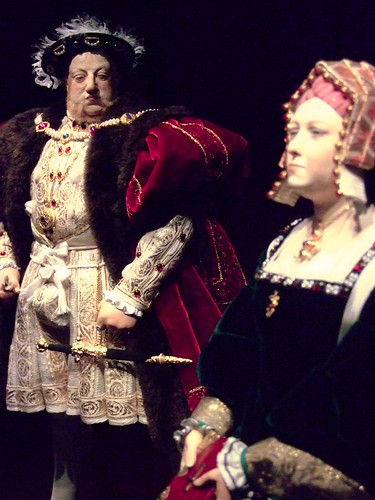

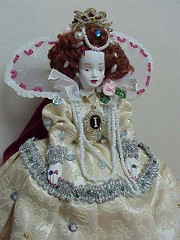
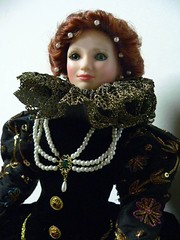

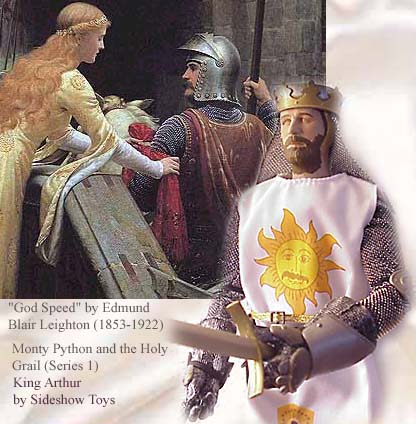
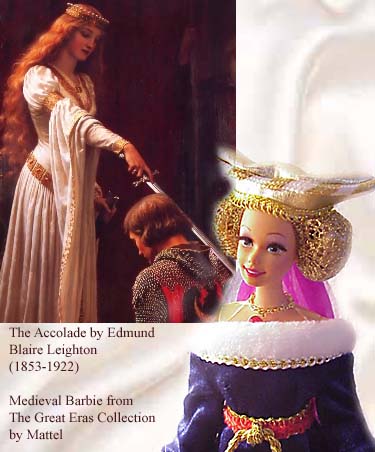
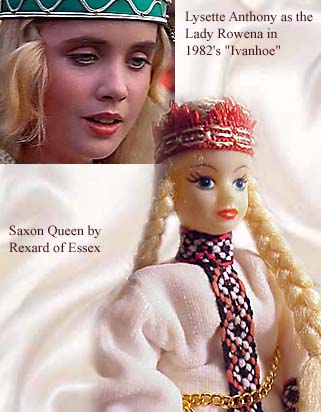
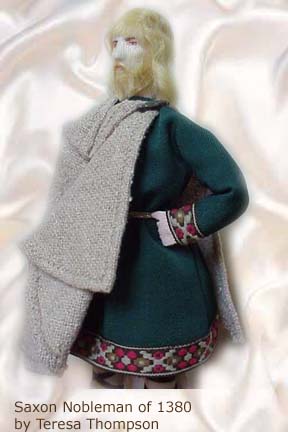 ose worn by men. Wealthy noblewomen might have broad borders of embroidery or braid at the cuffs and hem of these dresses, and in some cases another broad band running from the neck to the hem at centre front. In the case of extremely wealthy women the entire tunic may have been of patterned cloth or covered in embroidery. This tunic was cut very wide, and was probably based on the tunica colobium or tunica dalmatica of late Roman and Byzantine fashion. In England this garment was referred to as a cyrtel, although the Latin loan word tunica was borrowed into English as tunece."
ose worn by men. Wealthy noblewomen might have broad borders of embroidery or braid at the cuffs and hem of these dresses, and in some cases another broad band running from the neck to the hem at centre front. In the case of extremely wealthy women the entire tunic may have been of patterned cloth or covered in embroidery. This tunic was cut very wide, and was probably based on the tunica colobium or tunica dalmatica of late Roman and Byzantine fashion. In England this garment was referred to as a cyrtel, although the Latin loan word tunica was borrowed into English as tunece."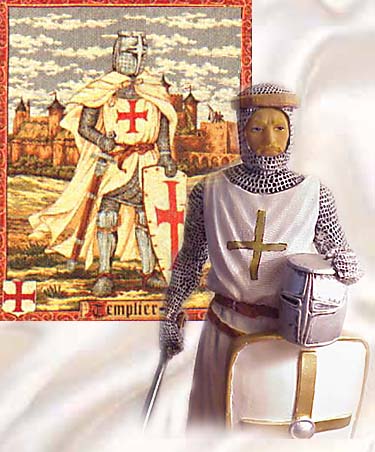 ms, but generally had a long, wide, straight, double-edged blade with a simple cross-guard (or "cruciform" hilt). The typical form was a single hand weapon used for hacking, shearing cuts and also for limited thrusting which evolved from the Celtic and Germanic swords of late Antiquity. Over time, the sword became more tapered and rigid, to facilitate thrusting, and began to add a series of protective rings to the hilt, to defend the fingers and hand. This was the birth of the "cut and thrust" or "sidesword."
ms, but generally had a long, wide, straight, double-edged blade with a simple cross-guard (or "cruciform" hilt). The typical form was a single hand weapon used for hacking, shearing cuts and also for limited thrusting which evolved from the Celtic and Germanic swords of late Antiquity. Over time, the sword became more tapered and rigid, to facilitate thrusting, and began to add a series of protective rings to the hilt, to defend the fingers and hand. This was the birth of the "cut and thrust" or "sidesword."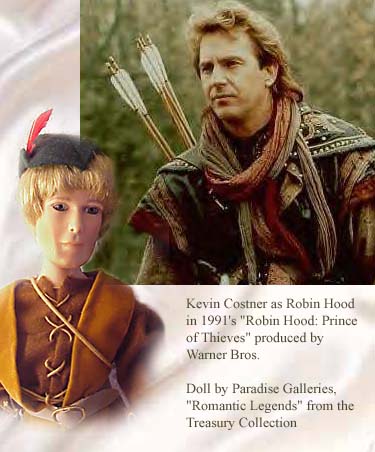 Another popular figure from the Middle Ages is
Another popular figure from the Middle Ages is 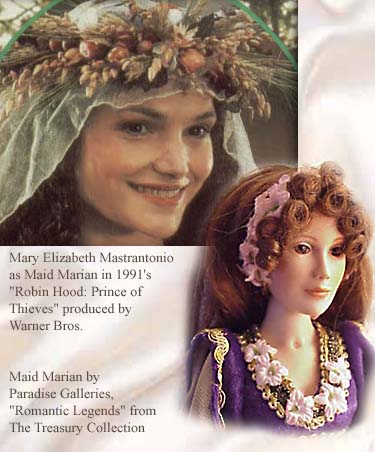 n.
n.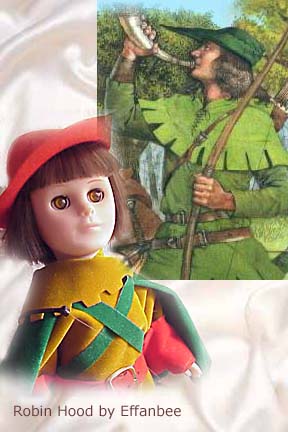 John, disguised as Reynolde Grenlefe, greets the sheriff who is hunting in the forest and "knelyd hym beforne" (line 729). When Little John tells the sheriff that he has just seen "a ryght fayre harte" (line 738) and a herd of deer, he foolishly asks to be taken to the spot where Robin, "the mayster-herte" (line 753), awaits him. After dining with the outlaw band, the sheriff is stripped of his clothing and forced to sleep on the ground. Begging to be released the next morning, he swears an oath that he will not harm Robin or his men in the future. Upon being released, he, humiliated but unharmed, returns to Nottingham where he
John, disguised as Reynolde Grenlefe, greets the sheriff who is hunting in the forest and "knelyd hym beforne" (line 729). When Little John tells the sheriff that he has just seen "a ryght fayre harte" (line 738) and a herd of deer, he foolishly asks to be taken to the spot where Robin, "the mayster-herte" (line 753), awaits him. After dining with the outlaw band, the sheriff is stripped of his clothing and forced to sleep on the ground. Begging to be released the next morning, he swears an oath that he will not harm Robin or his men in the future. Upon being released, he, humiliated but unharmed, returns to Nottingham where he 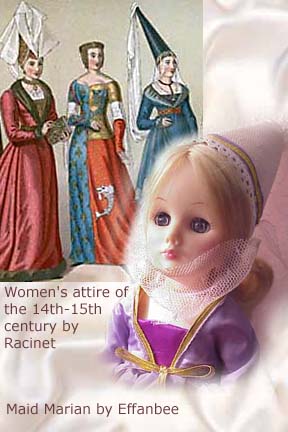 breaks his oath by plotting to capture Robin at the archery tournament."
breaks his oath by plotting to capture Robin at the archery tournament."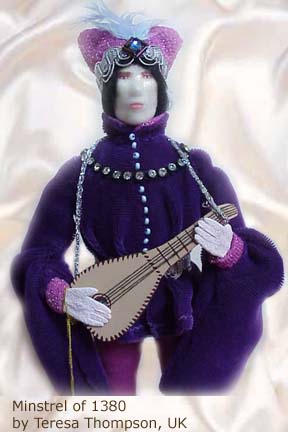 Wandering bards and minstrels also made their appearance in the Middle Ages. The first troubador poet was the grandfather of Eleanor of Aquitaine. Poets often recited tales of courtly love where gallant knights fought bravely to impress a lady that was unattainable because she was already married or betrothed.
Wandering bards and minstrels also made their appearance in the Middle Ages. The first troubador poet was the grandfather of Eleanor of Aquitaine. Poets often recited tales of courtly love where gallant knights fought bravely to impress a lady that was unattainable because she was already married or betrothed. 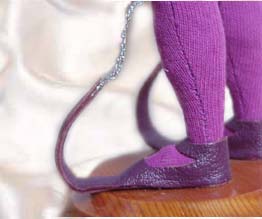
 Actually, one of the most realistic costume I have found on a doll -- or uuhumm - "action figure", graces a character from a parallel period, Middle Earth instead of the Middle Ages. The intricately detailed clothing for ToyBiz's 12 inch figure of Legolas from "Lord of the Rings: The Fellowship of the Ring" is exceptional. In the film, Legolas' archery skills certainly looked like they equalled those of Robin Hood. I do wish the figure would have had rooted hair, however. His long, pale blonde hair was one of his most attractive features. I guess "guys" would have thought it made the piece too much like a doll instead of the more masculine "action figure".
Actually, one of the most realistic costume I have found on a doll -- or uuhumm - "action figure", graces a character from a parallel period, Middle Earth instead of the Middle Ages. The intricately detailed clothing for ToyBiz's 12 inch figure of Legolas from "Lord of the Rings: The Fellowship of the Ring" is exceptional. In the film, Legolas' archery skills certainly looked like they equalled those of Robin Hood. I do wish the figure would have had rooted hair, however. His long, pale blonde hair was one of his most attractive features. I guess "guys" would have thought it made the piece too much like a doll instead of the more masculine "action figure".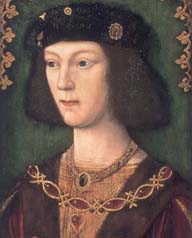
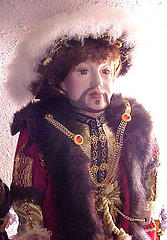
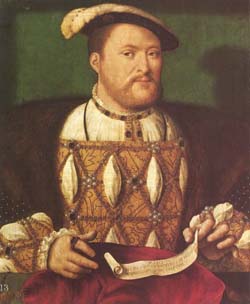 to the
actual women in Henry's life. They are beautiful however and
the costumes are lavishly adorned. I was able to purchase Henry
for
less than $30 although I've seen this doll sell for almost $50.
I purchased all six wives for only $22 each.
to the
actual women in Henry's life. They are beautiful however and
the costumes are lavishly adorned. I was able to purchase Henry
for
less than $30 although I've seen this doll sell for almost $50.
I purchased all six wives for only $22 each.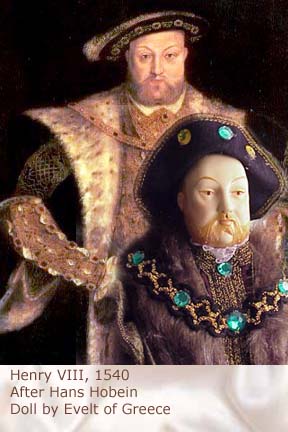 a daughter, Elizabeth.
a daughter, Elizabeth.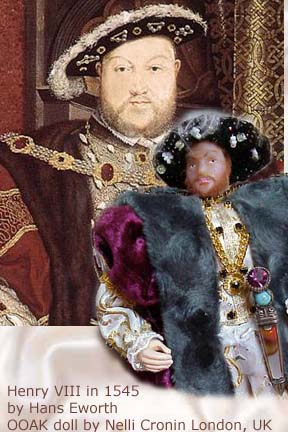 Ebay has opened up a whole world to doll collectors. I was the
successful bidder for a wonderfully detailed one-of-a-kind (OOAK)
Elizabeth I doll created by Nelli Cronin and she mentioned she
also had made a Henry VIII and all of his wives that I readily agreed
to buy as well. Nelli is originally from St. Petersburg, Russia
and is now married to an Englishman and lives in London. Her
finely
detailed Henry VIII is about 8" tall and is adorned with a
real human hair beard. Nelli visits Madame Toussaud's Wax Museum
and uses the wax figures there as models for some of her dolls.
Ebay has opened up a whole world to doll collectors. I was the
successful bidder for a wonderfully detailed one-of-a-kind (OOAK)
Elizabeth I doll created by Nelli Cronin and she mentioned she
also had made a Henry VIII and all of his wives that I readily agreed
to buy as well. Nelli is originally from St. Petersburg, Russia
and is now married to an Englishman and lives in London. Her
finely
detailed Henry VIII is about 8" tall and is adorned with a
real human hair beard. Nelli visits Madame Toussaud's Wax Museum
and uses the wax figures there as models for some of her dolls.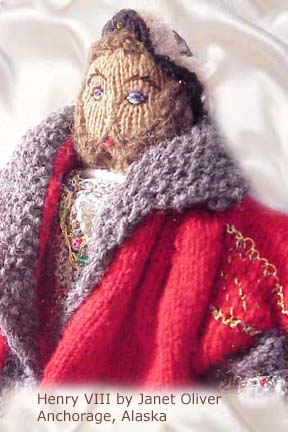

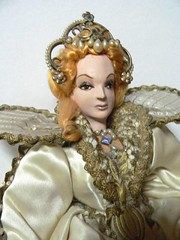 With
all this attention throughout history, it is not surprising that I found
so many different reincarnations of Elizabeth
in the doll world. Probably my most rare Queen Elizabeth doll is a portrait
doll by Ilse Ottenberg. Ilse and her German husband, Richard, were interned
as enemy aliens on the Isle of Man at the outbreak of World War II. To
occupy their time there, the Ottenbergs began making toys
With
all this attention throughout history, it is not surprising that I found
so many different reincarnations of Elizabeth
in the doll world. Probably my most rare Queen Elizabeth doll is a portrait
doll by Ilse Ottenberg. Ilse and her German husband, Richard, were interned
as enemy aliens on the Isle of Man at the outbreak of World War II. To
occupy their time there, the Ottenbergs began making toys 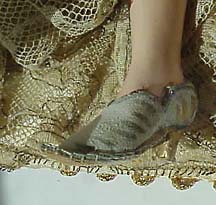 and soon involved
other internees in their work. After the war, the Ottenbergs turned toy
making into their primary livelihood. At the time of Queen Elizabeth
II's
coronation, Ilse submitted a commemorative doll to Buckingham Palace
for the Queen's approval for a franchise of dolls depicting the Royals
and
was one of only two dollmakers who were granted the license. Ottenberg's
dolls are highly detailed. Even the heeled shoes Elizabeth I wears are
carefully hand stitched.
and soon involved
other internees in their work. After the war, the Ottenbergs turned toy
making into their primary livelihood. At the time of Queen Elizabeth
II's
coronation, Ilse submitted a commemorative doll to Buckingham Palace
for the Queen's approval for a franchise of dolls depicting the Royals
and
was one of only two dollmakers who were granted the license. Ottenberg's
dolls are highly detailed. Even the heeled shoes Elizabeth I wears are
carefully hand stitched. 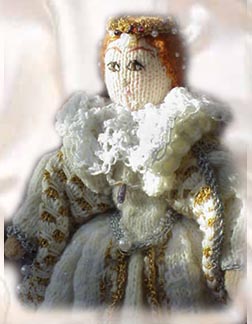 Ottenberg
dolls have been displayed at a number of British Embassies throughout
the world. I feel very fortunate to have obtained one of these dolls on
Ebay for a price of only $80. I continue to search for them (especially
her Cleopatra or Nefertiti dolls).
Ottenberg
dolls have been displayed at a number of British Embassies throughout
the world. I feel very fortunate to have obtained one of these dolls on
Ebay for a price of only $80. I continue to search for them (especially
her Cleopatra or Nefertiti dolls). 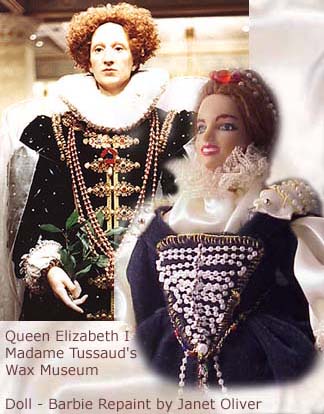 Janet's
Elizabeth Barbie is lavishly decorated with pearls, a trademark of the
this warrior queen. Sir Roy Strong in his book "
Janet's
Elizabeth Barbie is lavishly decorated with pearls, a trademark of the
this warrior queen. Sir Roy Strong in his book "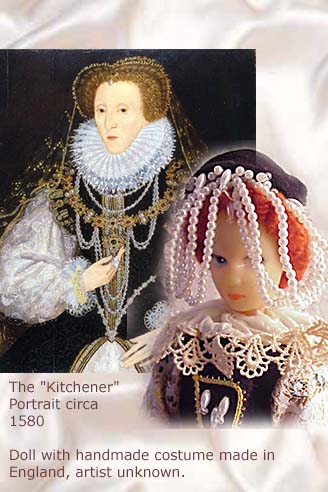
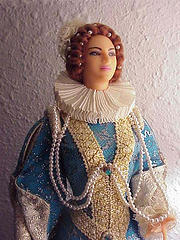 have
the broad smile of one of Marin's dancers and their hands are usually
in the same expressive pose. However, this rendition of Elizabeth draped
in her trademark pearls was more subdued although the queen would have
approved of the hands. Sir Roy Strong observes, "The Queen was particular
proud of her hands and contemporary accounts describe her making much
of taking her gloves off and often she is posed in portraits with her
hands gesturing or resting in front of her chest."
have
the broad smile of one of Marin's dancers and their hands are usually
in the same expressive pose. However, this rendition of Elizabeth draped
in her trademark pearls was more subdued although the queen would have
approved of the hands. Sir Roy Strong observes, "The Queen was particular
proud of her hands and contemporary accounts describe her making much
of taking her gloves off and often she is posed in portraits with her
hands gesturing or resting in front of her chest." 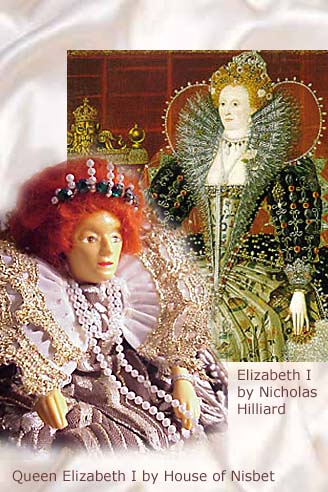 wonder
if she would have approved? Strong writes, "Her policing and concern
over her image was reflected in the Privy Council's order in 1596 to destroy
all portraits of her which were to her 'great offence'. Sir Walter Raleigh
in The History of the World of 1687 describes the works of 'common Painters'
being thrown in the fire. As a result we are justify with a smaller number
of iconic portraits; interesting because of their fine quality and because
they survived the Queen's rigorous editing. We are presented with images
of the Queen fashioned in the way she wished to be presented and make
her unmistakable."
wonder
if she would have approved? Strong writes, "Her policing and concern
over her image was reflected in the Privy Council's order in 1596 to destroy
all portraits of her which were to her 'great offence'. Sir Walter Raleigh
in The History of the World of 1687 describes the works of 'common Painters'
being thrown in the fire. As a result we are justify with a smaller number
of iconic portraits; interesting because of their fine quality and because
they survived the Queen's rigorous editing. We are presented with images
of the Queen fashioned in the way she wished to be presented and make
her unmistakable."